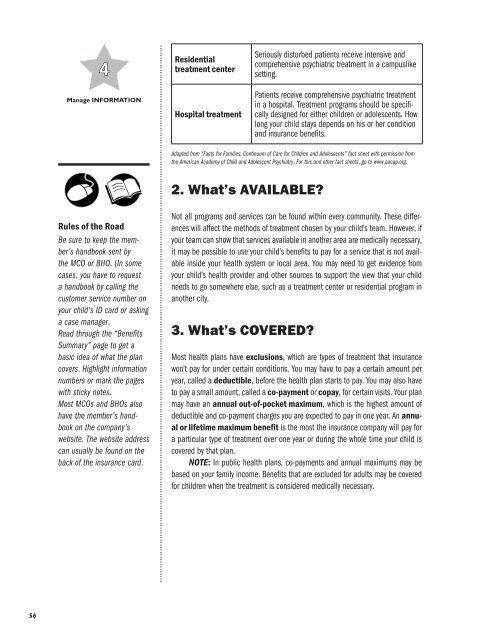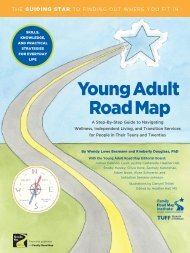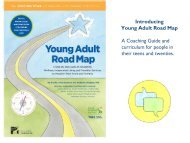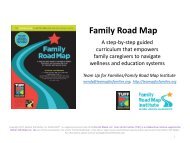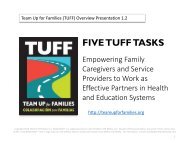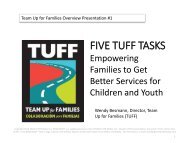Family Road Map Guide
Create successful ePaper yourself
Turn your PDF publications into a flip-book with our unique Google optimized e-Paper software.
4<br />
Manage INFORMATION<br />
Residential<br />
treatment center<br />
Hospital treatment<br />
Seriously disturbed patients receive intensive and<br />
comprehensive psychiatric treatment in a campuslike<br />
setting.<br />
Patients receive comprehensive psychiatric treatment<br />
in a hospital. Treatment programs should be specifically<br />
designed for either children or adolescents. How<br />
long your child stays depends on his or her condition<br />
and insurance benefits.<br />
Adapted from “Facts for Families: Continuum of Care for Children and Adolescents” fact sheet with permission from<br />
the American Academy of Child and Adolescent Psychiatry. For this and other fact sheets, go to www.aacap.org.<br />
2. What’s AVAILABLE?<br />
Rules of the <strong>Road</strong><br />
Be sure to keep the member’s<br />
handbook sent by<br />
the MCO or BHO. (In some<br />
cases, you have to request<br />
a handbook by calling the<br />
customer service number on<br />
your child’s ID card or asking<br />
a case manager.<br />
Read through the “Benefits<br />
Summary” page to get a<br />
basic idea of what the plan<br />
covers. Highlight information<br />
numbers or mark the pages<br />
with sticky notes.<br />
Most MCOs and BHOs also<br />
have the member’s handbook<br />
on the company’s<br />
website. The website address<br />
can usually be found on the<br />
back of the insurance card.<br />
Not all programs and services can be found within every community. These differences<br />
will affect the methods of treatment chosen by your child’s team. However, if<br />
your team can show that services available in another area are medically necessary,<br />
it may be possible to use your child’s benefits to pay for a service that is not available<br />
inside your health system or local area. You may need to get evidence from<br />
your child’s health provider and other sources to support the view that your child<br />
needs to go somewhere else, such as a treatment center or residential program in<br />
another city.<br />
3. What’s COVERED?<br />
Most health plans have exclusions, which are types of treatment that insurance<br />
won’t pay for under certain conditions. You may have to pay a certain amount per<br />
year, called a deductible, before the health plan starts to pay. You may also have<br />
to pay a small amount, called a co-payment or copay, for certain visits. Your plan<br />
may have an annual out-of-pocket maximum, which is the highest amount of<br />
deductible and co-payment charges you are expected to pay in one year. An annual<br />
or lifetime maximum benefit is the most the insurance company will pay for<br />
a particular type of treatment over one year or during the whole time your child is<br />
covered by that plan.<br />
NOTE: In public health plans, co-payments and annual maximums may be<br />
based on your family income. Benefits that are excluded for adults may be covered<br />
for children when the treatment is considered medically necessary.<br />
56


